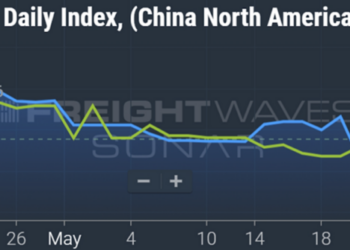A freight market in which demand remains healthy and truckload rates remain stuck in a relatively narrow range showing little ability to break out to a higher level was the focus of FreightWaves’ final State of Freight webinar for 2023.
Zach Strickland, FreightWaves’ director of freight market intelligence, kicked things off in his discussion with FreightWaves CEO Craig Fuller on Thursday by noting something that might be missed in a market of spot truckload rates that seem stuck near a bottom: Demand isn’t all that bad.
Here are some of the takeaways from Thursday’s webinar.
There’s not much sign of a freight recession when volumes are considered
In a year in which carriers large and small would describe the market as weak or worse, volumes actually have held up.
“Underlying all this has been actually a pretty decent demand-side environment,” Strickland said, referring to the Outbound Tender Volume Index (OTVI) from SONAR. “I think when we talked about this recently, we were almost kind of like, ‘This is weird. It shouldn’t be this way because normally supply and demand is a little bit more in balance in a tighter market.’”
Fuller agreed that the demand for freight has been far stronger than might be indicated by financial benchmarks such as rate per mile for truckload transportation.
In discussion of the “freight recession,” Fuller said some people have said to him, “Wait, volumes are actually pretty good. How do you describe this as a recession?” That leads to a question of definition and what exactly constitutes the freight market. “There’s so many different definitions of it, but I think we have to look at it from the state of volume,” he said.
And when that perspective is taken, the picture of a freight recession is not as clear. “Financial hedge funds understand what we’re seeing,” Fuller said. “Volumes have been strong and the economy has been stronger than any of us really would have guessed.”
But the OTRI is saying something different
As Fuller said after discussing the strong volumes on the demand side of the ledger, “for freight professionals, it doesn’t feel that way. And the reason it doesn’t feel that way is the market has been oversupplied with capacity.”
That led to Strickland putting up a chart that showed the increase in the Federal Motor Carrier Safety Administration’s granting of authorities. Since December 2019, authorities granted by FMCSA have risen about 40%, Stricikland said, but volumes are up about 14% during that time.
“This is not measuring trucks, it’s measuring operating authority growth,” Strickland said. “So this to me kind of displays the story of the freight market environment, possibly better than any other at this point because we have this huge glut of capacity.”
Fuller noted, “Carriers have taken about every piece of freight that they have been offered.”
The end result is that the Outbound Tender Rejection Index (OTRI), which measures contract loads rejected by carriers in a routing guide and thus is a strong benchmark of available capacity, remains below where it was a year ago, according to Strickland. On Thursday, the OTRI was 3.76%. A year ago it was 3.86%.
There are reasons to believe current conditions may be coming to an end
Fuller said the U.S. economy in general has been stronger and volumes have held up. “What happens if the market continues to bleed out capacity and there is a capacity problem?” he asked.
Shippers should probably be “playing a little bit more on defense than we have talked about in prior conversations,” Fuller said. Because even though capacity is still plentiful, freight market history shows that “there have been times when the capacity situation has changed so fast in terms of pricing.”
A capacity crunch could emerge by the second half of 2024, according to Fuller, who added he is “not calling for it.”
Given that, contract negotiations in the first half of 2024 could be “probably the last set of reductions shippers will give to their carrier base, because the cycle would be largely over with,” Fuller said.
Government has played a role in keeping volumes relatively strong
The Inflation Reduction Act (IRA) “has really driven a lot of money into the economy,” with a particular emphasis on manufacturing, Fuller said. And it wasn’t just a short-term hit. “We could continue to see more capital coming into the economy from these projects” that were enabled by the legislation.
In a recent meeting with a group of CEOs, a presenter from the European automotive industry said the IRA was “the most important driver of nearshoring and reshoring in history.” Its structure is leading to more automotive manufacturing in the U.S. as well as energy transition products such as battery plants. “I came out of there pretty bullish on what this means from a nearshoring and reshoring aspect that I don’t think we think about a lot,” Fuller said.
The salad days spurred by COVID are not likely to return
Asked by a webinar participant whether the type of linehaul rates that the truckload industry reveled in during the slow COVID recovery would return, Fuller said that the industry then “reached peak truckload. I don’t think we’ll see $4-per-mile rates for many years.”
Strickland agreed “that was an anomaly. Hopefully you enjoyed it while you had it.”
More articles by John Kingston
Takeaways from State of Freight: A surprising volume increase in July
State of Freight takeaways: Low rates, low OTRI mask market improvement
The State of Freight: 5 takeaways on Yellow’s fate and a UPS strike
The post State of Freight: Strong volume, stuck OTRI and caution for shippers in ’24 appeared first on FreightWaves.














